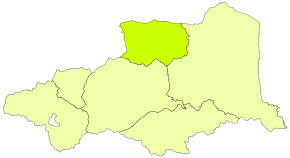Fenouillèdes

Fenouillèdes ( Occitan Fenolhedés / Fenolheda / Fenolhet ; Catalan Fenolleda ) is a traditional, until around the end of the 19th century okzitanischsprachige , Comarca in the south of France . Together with the other 5 northern Catalan comarques, it forms what is now the Pyrénées-Orientales department . The capital of the comarca is Saint-Paul-de-Fenouillet , but it owes its name to the town of Fenouillet .
Location and climate
The two northern Catalan comarcas Conflent and Rosselló are located in the south and south-east of Fenouillèdes, about 20 to 40 km (as the crow flies) from the Mediterranean Sea and the city of Perpignan . In the north and north-west, the mountainous region of the Corbières joins. Further to the northwest lie the southeastern foothills of the Lauragais . The most important rivers in the Fenouillèdes are the Agly and its tributaries Desix , Boulzane and Maury . Most places are at altitudes between 250 and 550 m ; the highest mountain peaks on the edge of the Fenouillèdes can reach heights of almost 1400 m . The climate is temperate to warm; Rain (approx. 750 mm / year) falls mainly in the winter half-year.
Communities
The historical heartlands of Fenouillèdes include the towns and communities: Ansignan , Bélesta , Campoussy , Caramany , Cassagnes , Caudiès-de-Fenouillèdes , Felluns , Fenouillet , Fosse , Lansac , Latour-de-France , Lesquerde , Maury , Montalba-le -Château , Pézilla-de-Conflent , Planèzes , Prats-de-Sournia , Prugnanes , Rabouillet , Rasiguères , Saint-Arnac , Saint-Martin-de-Fenouillet , Saint-Paul-de-Fenouillet , Sournia , Trévillach , Trilla , Vira and Le Vivier .
economy
Fenouillèdes' only export items are good red wines that are marketed under the Côtes du Roussillon appellation. Otherwise, the people live from tourism (rental of holiday apartments - gîtes ) and - to a limited extent - from agriculture and forestry.
history
prehistory
In the cave of Arago near Tautavel , the remains of prehominids have been discovered over several years in archaeological excavations since 1964, the age of which is estimated by research to be around 300,000 to 450,000 years. Thus the so-called human from Tautavel belongs to the group of Homo erectus and thus - long before the Neanderthals - to the oldest evidence of the presence of early forms of humans in Europe.
A large number of - mostly destroyed - Neolithic large stone graves ( dolmens ) from the time of the megalithic cultures indicate that the area was around 3000 to 4000 BC. Was settled.
Antiquity
While cities were founded in what is now Catalonia ( Empúries ) and Languedoc ( Agde ) during the Greek colonization of the Mediterranean , this has not yet been proven for the neighboring coastal strip of Roussillon. The region is generally regarded as a settlement area for the Celtiberians (cf. Sournia ). However, traces of Roman settlement are known (e.g. Ruscino near Perpignan ). The Ansignan aqueduct is the most important cultural legacy of the Romans in Fenouillèdes, although the former terminus of the aqueduct, i. H. the associated settlement is not yet known.
middle Ages
In the early Middle Ages, the Fenouillèdes formed part of the County of Razès ; in 870 it went to the Counts of Urgell and Cerdanya . Then the Abbey of Saint-Michel-de-Cuxa expanded its lands and founded a monastery in Saint-Paul.
In 990 Fenouillèdes became a sub-county of the Counts of Besalú and from 1111 of the Counts of Barcelona . In the following years it became a pawn for the Counts of Barcelona, Foix , Toulouse and Carcassonne in the course of the crusades against the Cathars . Finally, with the Treaty of Corbeil (1258) , the Fenouillèdes finally fell to the Kingdom of France . The transition from the Catalan to the Occitan language began.
Modern times
In 1790, during the French Revolution and long after the Peace of the Pyrenees of November 7, 1659, which brought the whole of Roussillon from Spain to France, the Fenouillèdes was integrated into the Pyrénées-Orientales department together with the northern Catalan Comarques.
Attractions
- Dolmens of Trilla and Ansignan
- Roman aqueduct of Ansignan
- Chapelle Saint-Michel de Sournia
- Gorges de Galamus with the Hermitage Saint-Antoine
literature
- Michèle Aué: The land of the Cathars. MSM Vic-en-Bigorre 1992, ISBN 2-907899-46-5 , p. 72.
Web links
- Dolmen near Ansignan - map, photos + info (in French)
- Dolmen of Trilla - map, photos + info (in French)







